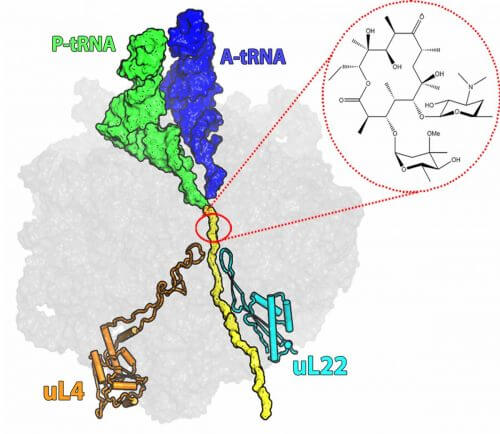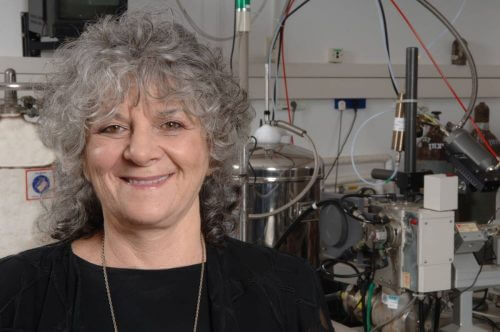Scientists from the Weizmann Institute discovered that the mutation in the ribosomal protein L22 changes the three-dimensional structure of a loop located at the end of the protein. Following this change, a "domino effect" takes place, the consequences of which reach the binding site of the antibiotic.

at the beginning of July Published The World Health Organization warning: due to the increasing resistance that the bacterium that causes gonorrhea has developed to antibiotics, it will not go far today, and this disease will not have a cure. The warning made headlines in newspapers around the world, but in fact, this is not an unusual case: the flourishing of "superbugs", which have developed resistance to the existing types of antibiotics, is a danger that lurks at the doorstep of humanity, and threatens to set medicine back more than 70 years, into an era The pre-antibiotics.
To keep the danger at bay, new types of antibiotics must be developed and the effectiveness of the existing types must be increased. To this end, the exact molecular mechanisms of the activity of these drugs must be thoroughly understood, as well as the resistance mechanisms developed by the bacteria. A new study by scientists from the Weizmann Institute, ShRecently published in the scientific journal Structure, cracked one of the resistance mechanisms to one of the oldest antibiotics - erythromycin.
Antibiotics are not a human invention, but a natural defense mechanism of bacteria that was discovered in the 20s of the last century, and came into clinical use after World War II. Bacteria produce antibiotics with the aim of eliminating other bacteria as part of "control struggles" between bacterial populations. Just as bacteria produce antibiotics, they also develop defense mechanisms against it. Thus, bacterial resistance to antibiotics exists in nature regardless of human actions.
However, the widespread use of antibiotics by humans has accelerated the rate of development of resistance, greatly increasing the prevalence of "superbugs". Even the antibiotic erythromycin, which was discovered in 1949 and is still in clinical use today, is actually produced by a bacterium. Erythromycin belongs to the macrolide family, a family of antibiotics that work by binding to the ribosome, the cell's "factory" for protein production. The drug disables the ribosomes in the bacterial cells, thus preventing them from producing proteins, and ultimately causes their extinction.
"People today die from infectious diseases such as pneumonia, and not only in third world countries. These findings may help the development of future drugs that can overcome the bacteria's resistance mechanisms"

About 40% of the antibiotic preparations in use work by binding to the ribosome, but each of them has a different mechanism. For example, the erythromycin molecule binds to the area known as the "exit tunnel", through which the proteins formed in the ribosome exit. Following this binding of the drug, the tunnel is blocked, and the production of the proteins in the bacteria is inhibited. In most of the bacteria that have developed resistance to erythromycin, a mutation has occurred, which does not allow the molecule to connect to the binding pocket at the entrance of the tunnel, and thus fulfill its role. However, in some cases, even when the erythromycin molecule was bound to the ribosome, the bacteria managed to develop resistance to it, for which no explanation has been found so far. This resistance is the result of a mutation in a ribosomal protein known as L22.
Dr. Itai Wekselman, who led the research as part of his doctoral thesis in the laboratory of the Nobel laureate in chemistry, Prof. Ada Yonat, in the Department of Structural Biology at the Weizmann Institute, explains the mystery surrounding this resistance mechanism: "The antibiotic molecule has no contact - no chemical connection - with the protein in which a mutation occurred. In fact, this protein is relatively far away, in chemical and structural terms. Nevertheless, although the mutant protein does not apparently interfere with the action of erythromycin, resistance to the antibiotic has developed here."
To solve this riddle, Dr. Wexelman, Dr. Anat Bashan, Dr. Ella Zimmerman, Dr. Haim Rosenberg and other members of Prof. Yonat's group, in collaboration with Dr. Janice Zengel from the University of Maryland in the USA and Prof. Hannah Ingmar from the University of Copenhagen in Denmark, for the many years of groundbreaking work by Prof. Yonat who deciphered the structure of the ribosome, and even developed advanced possibilities of use in the field of crystallography using X-rays, thanks to which the three-dimensional structure of the ribosome can be deciphered with a level of precision close to atomic resolution . This is how the researchers were able to obtain electron density maps of the ribosome structure with and without the mutation, as well as in the presence and absence of the erythromycin molecule.
Following this mapping, it was discovered that the mutation in the protein changes the three-dimensional structure of a loop located at the end of the L22 protein. Following this change, the loop expands and moves towards the center of the tunnel, then a "domino effect" takes place, which changes the position of a number of RNA bases that make up the wall of the tunnel. As a result of these spatial changes, which reach the binding site of the antibiotic, the erythromycin molecule does manage to bind to the binding pocket, but the tunnel is not blocked - and the bacteria can continue to grow.
"If the pharmaceutical companies do not think and act quickly, within twenty to thirty years we will return to the period before the use of antibiotics"

Recently Released in the scientific journal mBio Another study by Prof. Yonat's laboratory, in collaboration with researchers from Monash University in Australia and Nanyang Technological University in Singapore. In this study, the scientists revealed, with the help of modern methods in electron microscopy, the molecular mechanism that allows Staphylococcus aureus to escape antibiotic treatment.
Dr. Bashan explains the importance of these studies: "People today die from infectious diseases such as pneumonia, and not only in third world countries. These findings may help the development of future drugs that can overcome the bacteria's resistance mechanisms." However, the number of new antibiotic drugs entering clinical use is not large, since pharmaceutical companies do not invest enough resources in the development of new types of antibiotics, due to the little profitability expected from these preparations. Prof. Yonat warned about this in the past: "If the pharmaceutical companies do not think and act quickly, within 20-30 years we will return to the period before the use of antibiotics."
#Science numbers
The World Health Organization recently warned that the number of deaths due to resistant bacteria may increase to 10 million cases per year by 2050 - more than the number of deaths due to cancer and diabetes combined.
See more on the subject on the science website:
- "Antibiotics are like an atom bomb on the microbiome"
- Researchers have developed a system that allows rapid personalization of the antibiotic drug for the patient
- Researchers have developed a technology that allows the "reprogramming" of bacteria
- Researchers have developed antibiotics against antibiotic-resistant bacteria

26 תגובות
my father
In the article you linked to, I did not find what you are quoting.
On the contrary - write exactly what I said...
for miracles
According to the instructions of the Israeli Ministry of Health, all clothing in the operating room must be sterile (at least at the beginning of the operation)
chrome-extension://oemmndcbldboiebfnladdacbdfmadadm/https://www.health.gov.il/hozer/mr24_2001.pdf
I didn't check what the FDA requires, but apparently the FDA also requires it for you.
The producers...lol
Yigal
…they will still eulogize you…. 🙂
got it.
Do not eulogize them quickly.
Thanks Nissim.
Yigal
Penicillin saved between 12% and 15% of wounded soldiers in World War II.
Did you understand that Baruch?
Miracles, my father
Dear All
Please your references
Again:
Ferrier who manufactures and develops new-antibiotics-for-use-outside-hospitals
; It becomes a weaning material for the global animal food industry; which at an exponential rate brings resistant bacteria upon us (most of us will not die in return)
Avi ,
What's new ?
For more than 5 years I have been seeing socks made of fabric woven with silver threads that kill bacteria in every one of the pharmacy chains.
Why not use this fabric in the hospital wards in Israel for all the followers?!
my father
An operating room is not sterile at all, don't kid yourself. What is sterile is the surgeon's (and one nurse's) gown cover and everything that touches the patient in the area of the surgical incision. The head covering and the mask, for example, are not sterile.
All other people in the operating room wear a clean head covering, mask and gown, and in some operating rooms also cover shoes.
I'm not familiar with "germicidal" fabrics, and if it's a new patent then you probably won't find a standard for it yet.
I know standards for sterilization and disinfection of operating room equipment and clothing, etc., but I don't think that's what you're looking for.
For example, clothing for operating rooms should be "sterile" with no bacteria at all, (according to the pharmacopoeia, sterile means that there is a probability of less than 1 in a million to find bacteria on the fabric.)
Correction to Lanik
http://www.health.gov.il/LegislationLibrary/health-mazon29A.pdf
As far as I know, there is no such standard in Israel, nor is there a ban, so why would they check at all?
"All over the world" I have no idea.
Organic products must not contain antibiotics at all, and it is possible that the bodies that give the "organic" certificate check.
But I do not know and do not deal with such products.
There are regulations for pesticide residues but this does not include antibiotics
See on the website of the Ministry of Health there is material on quality requirements for food
https://www.health.gov.il/UnitsOffice/HD/PH/FCS/contaminants/Pages/pesticides.aspx
Public health regulations "pesticide residues":
chrome-extension://oemmndcbldboiebfnladdacbdfmadadm/https://www.health.gov.il/LegislationLibrary/health-mazon29A.pdf
With your permission, father, (in addition to the law abroad on the prohibition of antibiotics in food) if it is not difficult,
also:
If you know an American or European standard number
To use germicidal fabrics in all hospital supplies (sheets, blankets, robes, pajamas, towels, personnel clothes, etc.)?
Regards.
To my dear father,
I don't understand, you want to tell me that in no country in the world is there a single law that prohibits inventions-antibiotics
In chicken, beef, fish and egg products?!
(I am looking for an international reference as a platform for the law in Israel because I want to reduce the massive exposure of bacteria to antibiotics and the process of the bacteria becoming completely immune to antibiotics even if only slightly)
Legal
There is no such standard.
Each antibiotic substance has a different level of toxicity, for each such substance it is written in its MSDS what is the maximum level allowed when it is taken as a medicine, and this differs from substance to substance, and it is in much larger quantities than can be in food.
When a chicken or cow receives antibiotics, the substance will be found in eggs or milk or meat at much lower levels, therefore they do not pose a risk to the consumer of the food, therefore they are not tested, and there is no standard for a permissible level.
In addition, since in principle there should be no antibiotics at all in the food, and there is also no technical possibility to test every food for all the types of antibiotics that exist.
On the other hand, dairies like Tnuva test certain levels of antibiotics in the milk, and it's not because they worry about the consumer being harmed by the antibiotics, but in the dairy industry bacteria are used to create cheeses and whites... and these antibiotics that are in the milk spoil the process.
Poultry receive antibiotics in large quantities and therefore poultry meat contains a lot of antibiotics as well as eggs and we receive these unnecessary antibiotics with the food.
The consumer has the option of buying organic eggs and milk and poultry raised without antibiotics...
By the way, my father
Perhaps you have an idea about a standard for maximizing the amount of antibiotic inventions per unit of weight of animal food suitable for human consumption (in Israel or in the world)?
If the breeder tells you that the herd had the flu, what will you say?
I once visited a kibbutz and toured a dairy and was horrified by the entry on their cow monitoring board: many of the cows had been given antibiotics.
There is no doubt that the issue of sanitation in hospitals needs to be addressed.
At the same time, I think there is a place to ban the use of antibiotics without control in agriculture - it is also not healthy to have antibiotics in the milk and meat we eat.
If there was supervision of antibiotics in food, for example testing and disqualification of food containing antibiotic residues, fines for farmers... it would help.
In the past, hormone-based growth stimulants were used, it was banned, and today they have switched to antibiotics, so just as this ban helped the use of hormonal growth stimulants, it will help if there is a ban on antibiotics.
We cannot monitor every chicken and cow breeder. He buys bags upon bags of antibiotics to treat so-called infections and at the same time wean the animals with the fact that they grew fast and thus achieve a short time to market.
What, my father? Shall we start monitoring the importer of the antibiotic bags for agriculture? (He's not a bad name either! Money money money)
Again, in my humble opinion, it is not worthwhile for me as a pharmaceutical company to invest in the development of new antibiotics for administration outside the hospital
Because of what I said below - the farmers and importers will spread what tons upon tons.
In my opinion, the direction is to develop new drugs only for the locked medicine cabinet of the hospitals and replace all the clothes, sheets, towels and blankets in hospitals with only the germicide
Hospitals are the place where the resistant bacteria are spread between humans, especially the pathogenic and opportunistic ones (these are the most dangerous because they grow on a healthy person and in a hospital they attack people with a weak immune system, for example Staphylococcus aureus).
Taphylococcus aureus is a bacterium that grows on humans and animals and does not cause any harm until it reaches a wound or surgical scar, and causes inflammation there. In a sick person whose immune system is also weak, it becomes life-threatening.
The initial evolution of these bacteria during which they become resistant to antibiotics takes place in the agricultural sector.
I agree with you, father, but the money is over.
What about my thesis of the hospital board for a dangerous hatchery and the urgent solution that needs to be done there?
The problem is in agriculture - where antibiotics are used the most - farm animals like chickens and cows get tons of antibiotics just like that because it "helps them get fat".
In the agricultural economy, many types of bacteria meet with antibiotics and in the process of conjugation and natural selection, resistant bacteria are created.
The pharmaceutical industry, with the help of science of course, is constantly developing new types of antibiotics.
History shows that as the bacteria develop resistance, science also develops new types of drugs, from time to time science lags behind a certain bacteria, but after some time the problem is solved.
I totally understand the hesitancy of pharmaceuticals: who would want to invest millions of dollars for 10 years of my life on a new antibiotic.
Again: Tomorrow, in my opinion, is a revolution of all hospital equipment and infrastructure to a powerful germicide: fabrics, paints, coatings, etc.
Because of the widespread use of antibiotics, and I think it will eventually be widespread with the new antibiotics as well,
The main key lies in preventing the spread of bacteria within the hospital (anti-bacterial fabrics, anti-bacterial paints, flooring as above, and the air conditioning system as above, and the coating of the beds, the furniture and the medical equipment.
The end of the effect of antibiotics is a danger to all of humanity, therefore, in my opinion, the UN should initiate, from the funds of its member states, the development of new drugs to replace antibiotics (or, of course, new antibiotic drugs), and tender the patent for production and distribution to the pharmaceutical companies. The money received will later finance the development of additional new drugs.
Of course, it is also possible to launch a new campaign in the sanitary field, including investments in hospitals (increasing the space between beds, for example) and in preventive advocacy in the third world and in the State of Israel, of which it is a part, but the chances of this happening are much smaller.